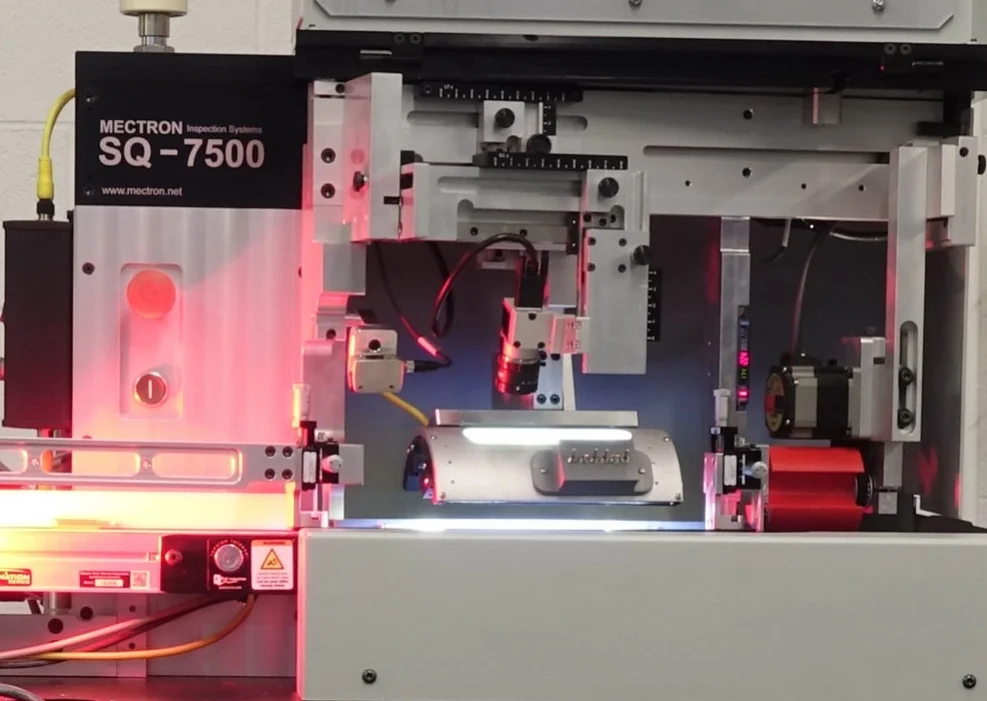Surface Inspection
Mectron’s new patent pending Surface Qualifier 7500 (SQ-7500) is a camera-based system that uses statistical learning to inspect cylindrical parts. The parts traverse the machine by being rolled along an angled rail by a conveyor belt so that the camera can get 360 degrees of images to inspect the part.
SQ-7500 Bearing inspection.
SQ-7500 Ammunition Inspection
MACRO-DATA ANALYTICS
Surface inspection for ammunition, bearings and more.
The system is capable of obtaining and analyzing over 100 million data points per second. Using statistical learning the SQ-7500 can analyze each data point in a matter of milliseconds. The camera takes images of the surface of the part at a rate of up to 400 images per second; each image contains 98,850 data points. This speed is possible by using a GPU (Graphics processing unit) instead of a CPU. Until the surface qualifier, only CPU’s have been used in inspection, which typically can have at the most 48 cores. The GPU has over 2,050 cores. GPUs were developed for the video gaming industry and for the graphics displays on video gaming consoles. Since we are using cameras it was possible to adapt the use for inspection at incredibly high speeds. The SQ-7500 uses controlled light reflections and Mectron’s in house developed statistical learning software to detect surface defects.
The machines first collects data on good parts known as the master set. The Master set tells the software what is considered normal and acceptable for a given part. All parts that are run through the machine are compared to known master parts using Mectron’s new statistical analysis software. The inspection method is based on a comparative test and inspects each received data point to build an overview of the part. Using the master method, you can account for part-to-part variation while still finding defects.
Module Design
The SQ-7500 is a modular system that can have up to three stations. Two camera stations and one eddy current station for crack detection. Eddy current uses a differential probe to make a tight helical scan on the part. The differential probe allows for some lift off and maintains accuracy while the part traverses the machine. The back camera station looks at the back of the part as it moves along the belt and detects defects on the back of the part, as well as reads patterns or characters.
After all stations inspect the part, they either accept or reject based on preset limits. If the part is accepted it will go into the rotary gate and be moved into the acceptance chute. If any station sends a reject signal, the rotary gate will not move and the part will go straight through to the reject bin. The system uses positive acceptance making it a fail-safe gate. It is capable of working as either a stand-alone machine, or mated with a Mectron Qualifier, LT-series, or MI8500 machine.
EDDY CURRENT INSPECTION
The quick connect differential eddy current probe uses Mectron's EC600 eddy current instrument. The EC600 is a new instrument developed by Mectron with software designed specifically for crack detection. A touch screen allows for simple operator interface to control the eddy current’s visually displayed signal. The displayed eddy current signal can then be manipulated by controls to alter the frequency, phase, horizontal and vertical gains, to maximize the difference between cracked fasteners and good fasteners. The EC600 has the capability to detect cracks as small as .005” (0.12mm). It is patent pending and can be added to any existing SQ-7500 due to the modular design.
The user interface displays the signal from the probe as the part is rotated beneath it. The differential probe uses two coils, both using eddy current. As a crack comes into the field, one filament will register a different signature than the other. The output shown is the difference between the two probes.
As the part moves through the machine, the probe will take a helical scan of the part. As the helix gets tighter, the probe can catch smaller and smaller cracks. The helix will get tighter as the angle of the guide rail gets smaller. Changing the angle of the guide rail is one simple mechanical adjustment.



